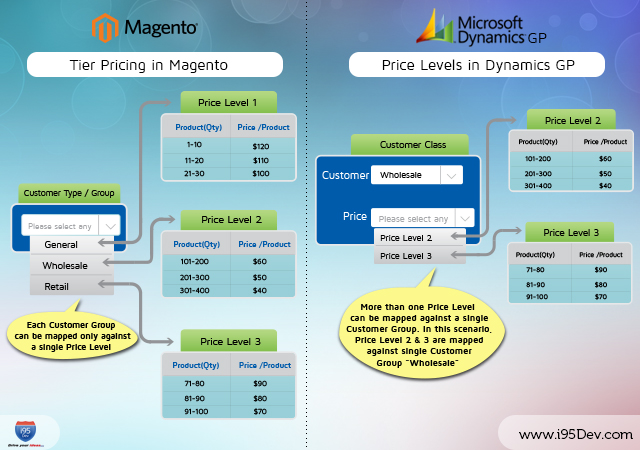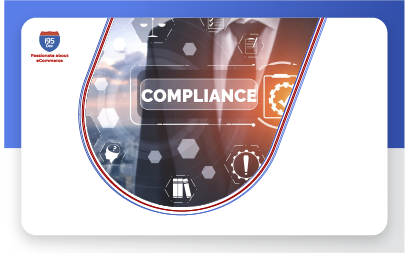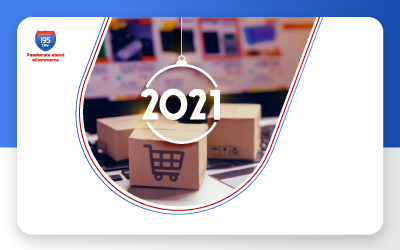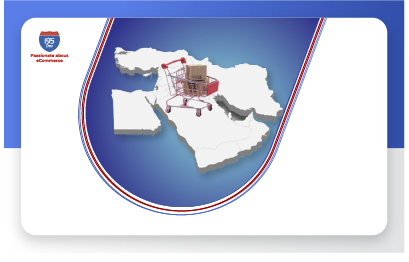Integration Doesn’t Make Magento
or Dynamics GP Redundant – Part 1

Businesses of all sizes, both B2B and B2C, are realizing the benefits of better leveraging their Dynamics GP system by integrating it with their Magento online store. But, while they understand the many benefits of integration, they sometimes forget that Dynamics GP and Magento are two very different systems designed to meet very specific requirements. While the integration enables the two systems to interact with each other, it would be unrealistic to expect one system to replace or replicate the functionality of the other. Through a series of three blogs, we will highlight some differences between the two systems to help you appreciate the complexity of integration while better understanding its limitations.
In this article, we have highlighted several features that have an impact on customer pricing – Tier Pricing/ Price Levels, Special Price, Catalog Price Rules and Shopping Cart Price Rules.
Tier Pricing/ Price Levels
Tier pricing (in Magento) / Price Levels (in Dynamics GP) are features that enable businesses to offer customers quantity-based discounts. As mentioned, Magento refers to this feature as Tier Pricing and Dynamics GP as Price Levels. While the objective of both is to provide quantity-based discounts, the manner in which the information is mapped and used in the two respective systems is very different.

Let’s consider a scenario wherein you have two customers, Allan and Viv, belonging to the “General” Customer Group. Belonging to the same Customer Group, both Allan and Viv will get the same discount associated with the Price Level mapped to their Customer Group. If, as the retailer, you feel that Allan is a better customer than Viv and want to give him a better price without moving him to a different Customer Group, you can’t turn to Magento but can use Dynamics GP. This is because Magento’s Customer Groups can only be mapped to one Price Level, whereas, in Dynamics GP, a Customer Group can be associated with multiple Price Levels.
Hence, with integration, while we can interconnect Tier Pricing in Magento with Price Levels in Dynamics GP the functionality offered in Dynamics GP cannot be exactly replicated.
Special Price
The Special Price feature enables businesses to offer customers a promotional special price that is different from the base price of the product. This feature is only available in Magento and is different from Discount. But if this feature is not available in Dynamics GP, then how will an order created in Magento be synced with Dynamics GP, considering that the price a customer pays in Magento is different from the price associated with the item in Dynamics GP?
Consider a scenario where you usually sell a cake via Magento at the Base Price of $17 (the price also listed in Dynamics GP) but want to sell it at a Special Price of $15 to your holiday season customers. Because Magento supports Special Price, you have updated the Special Price for the cake in Magento. Now your customers purchase the item at the discounted price but you cannot sync this order information with Dynamics GP, where the Base Price is still $17. But not syncing with Dynamics GP can be disastrous because you can’t fulfill your orders unless you transfer them to Dynamics GP. So how do you address this impasse?
i95Dev’s Magento GP Connect has effectively addressed this issue but it’s important to note that not all features available in Magento can be replicated in Dynamics GP, and vice versa.
Similarly, Magento offers businesses multiple other options like Catalogue Price Rules and Shopping Cart Price Rules, which are only available in Magento and not in Dynamics GP. Both Catalog Price Rules and Shopping Cart Price Rules are explained below for your reference:
Catalog Price Rules
Catalog Price Rules enable businesses to offer customers a different price based on some predefined rules. Catalog Price Rules are applied to products before they are added to a shopping cart. They can be used to create sales and discounts that do not require a discount code supplied by the customer.
An example of a Catalog Price Rule would be “Offer a 10% discount to A, B, and C SKUs which have a price greater than $20”.
Shopping Cart Price Rules
Similar to Catalog Price Rules, Shopping Cart Price Rules enable businesses to offer customers a different price on some predefined rules. But unlike Catalog Price Rules, which are applied to products before they are added to shopping cart, Shopping Cart Price Rules are applied when a customer reaches the shopping cart checkout. They can be applied either with or without the customer entering a coupon code, and include features not found in traditional coupon tools.
An example of a Shopping Cart Price Rule would be “Offer a 10% discount if the Shopping Cart total exceeds $100”.
To summarize, there are customer pricing features present in both Magento e-commerce and Microsoft Dynamics GP that do not map perfectly to each other. While integration is a worthwhile effort that saves time, better serves customers and increases sales, we cannot – in all instances – expect it to render one system redundant.
How can i95Dev help?
Regardless of the size of your company, you may want to consider the benefits of integrating your e-commerce store with your ERP or upgrading your current configuration. To learn more or to request a demonstration, please feel free to connect with us at http://www.i95dev.com/contact/or give us a call at 301.760.7499.

















